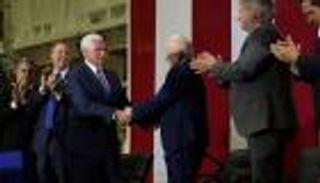The traditional "Apollo" computer played a historic role, although its power is millions of times lower than any smartphone in our contemporary world.
The secrets of the first trip to the moon in the sixties of the last century will remain an example of the fact that relying on computers is fraught with dangers.
In the first space flight, which was called the Apollo flight in 1961, computers were used, which were considered a calculator that could perform a set of mathematical operations.
The missions of the flight were the first in which the computer was used for navigation, but any defect that might occur in the software used was forbidden. The pioneers' lives are at stake.
Despite the famous warning signs that aroused fear in the same Neil Armstrong upon his descent to the moon, the performance of the "Apollo" computer was completely successful, and this device established the rules of air navigation and contemporary exploration systems.
But how could the "Apollo" computer, called in English "Apollo Guidance Computer" AGC, perform this historic role despite its power being millions of times lower than any smartphone in our contemporary world?
- The Chip Revolution
Integrated circuits or electronic chips were essential in the development of computers of the size required to be placed on board spacecraft instead of the large cylindrical computers that preceded them.
The chip was not invented by NASA, which is credited to Jack Kilby (of Texas Instruments) and Robert Noyce, founder of Fairchild Semiconductor and Intel.
However, "NASA" with the US Army, which needed the chips to direct its ballistic missiles towards the Soviet Union, accelerated their development through the huge demand for them.
"They were asking for an unimaginably high level of trustworthiness," space flight historian Frank O'Brien, author of a reference book on the Apollo computer, told AFP.
In the early sixties, NASA and the Pentagon bought one million electronic chips, according to the historian, which prompted manufacturers to produce chips that lived for longer periods compared to the few hours during which the basic chips lasted.
- Multitasking
Modern computers and smartphones are great at managing a large number of tasks simultaneously.
But, on the other hand, the first computers "did not have many tasks to carry out, and their function was limited to performing calculations and taking the place of humans in carrying out these operations," according to Seamus Toohey, director of space systems at the "Draper" company that emanates from the laboratories of the University of " MIT, where the Apollo machine was designed.
However, this all changed with the Apollo computer. The suitcase-sized device had to perform a number of vital functions, including navigation, oxygen and temperature management, and carbon dioxide purifiers so that the astronauts could breathe clean air.
Unlike the first computers, through which a person gave the machine a series of calculations waiting for the result (which may sometimes require days to appear), it was necessary for the "Apollo" computer to be fast to keep pace with the spacecraft's journey around the moon and receive orders from the crew in real time .
Also, NASA wanted an independent computer; Because she feared the Soviets would disturb communications between the flight crew and the control center on the ground.
It all required an informational "architecture" designed mainly by engineer Hal Lanning.
- Revolutionary Innovation
NASA engineers also wanted to move to a more advanced stage compared to the punch cards in early computers.
They invented 3 main elements, which are the operating keys that are currently in the cockpits of aircraft, and the control sticks that managed the system for the first time electronically, while the third element was similar to a keyboard called "DSKY", which constituted a revolutionary invention in that era.
On this keypad, astronauts could type two-digit codes to form commands, such as "start the engines".
- A successful experiment
While the lunar module was landing on the moon with Neil Armstrong and Buzz Aldrin, the Apollo computer's siren sounded several times, giving the impression that the mission was doomed to failure.
If this actually happened, the vehicle would not have been able to correct its height, speed, and trajectory, and therefore its crash would have been possible.
But on the ground at the Houston Control Center, NASA engineers quickly understood that the alarm was due to an information glut in the computer; In fact, all the systems were working fine.
But thanks to clever programming, the computer was able to automatically reduce the tasks entrusted to it, and suspended some jobs to give priority to the basic tasks needed to land on the moon.
Frank O'Brien, a specialist in astrophotography at the Smithsonian Institution, said, "The performance of the computer at full capacity was a real breakthrough."
